Deadly boats
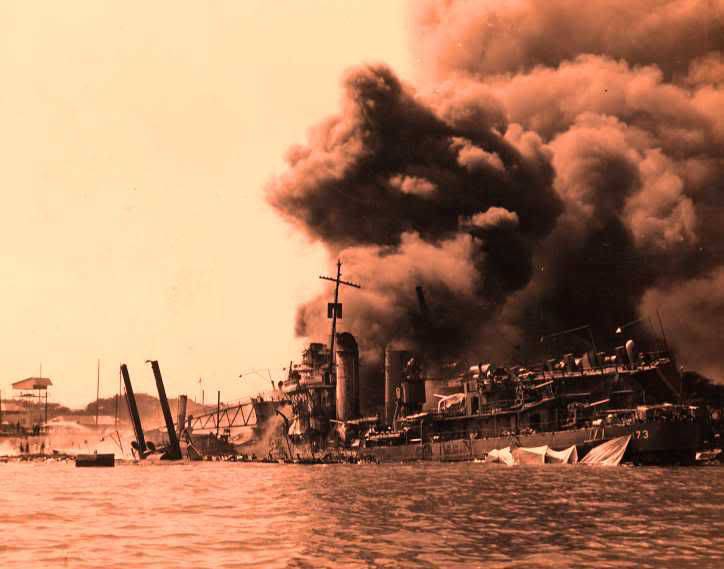
Even today, the circumstances of the death of the British cruiser "York" are interpreted in different ways. Some authors attribute its destruction to Germanic aviation, others indicate the successful operation of Italian underwater swimmers. The third version is true: a powerful heavy cruiser was the victim of an attack by six small vessels from the so-called "10th flotilla MAS. "
The fighting of underwater swimmers - demolition men using human-guided torpedoes is widely known; The episodes connected with the attacks of ultra-small submarines standing in the bases of the ships are covered in detail in the literature. There are fewer known cases of using such surface assault vehicles as high-speed boats filled with explosives, manned to overcome obstacles and aiming at a target, and then playing the role of torpedoes - undermining this goal at a time when the helmsman had already left the boat.
History these ships has more than one century. The first exploding ships were the sailors of the era of the sailing fleet, which were low-value ships loaded with combustible and explosive substances, intended to burn enemy ships. These vessels, on the yards of which boarding hooks were attached, were allowed to go downwind or downstream, most often at night or in fog.
Despite the very numerous facts of application, in the history of sea battles you can find not so many cases when firefighters caused significant harm to the enemy, because, in fact, the main purpose of sailing firefighters was to cause panic, set fire to one or two ships and break the system. It is worth noting that the Russian fleet also actively used firefighters. Including in such famous battles as the Chesme and in the battle of Gangut. In the Chesme battle, a brander under the command of Lieutenant Ilyin grappled with a Turkish battleship and was set on fire, then the fire went to the other ships. Then 16 of the Turkish ships, 6 frigates and more 50 smaller ships were destroyed.
But the XIX century brought its own rules. There were new, more long-range and rapid-fire weapons, which allowed to shoot and sink the enemy brander at a safe distance. And besides, the iron ships fire ceased to cause serious damage. All this forced to change the methods of using firewalls. Now they were supposed to become explosive and high-speed, and besides, it is also desirable to be small in size. And the branders continued their work in the twentieth century.
There are many cases of using the idea of a self-propelled brander during World War I and World War II, most often for the destruction of coastal defenses. So, 27 March 1942, while attacking the base of German submarines in Saint-Nazaire, a group of British "commandos" battalion of the dock was destroyed with the help of the Campbelltown destroyer filled with 5 tons of explosives. The destroyer from the course rammed the bataport and sank, and then was blown up by a clockwork. But much more widespread in the Second World War were still small in size exploding boats.
The use of explosive boats induced by a driver during World War II was not a special novelty: there was already some experience of their combat use, in particular in the Italian and German fleets.
You can, for example, find information about the Italian boattank "Grillo", built in 1915, specifically to overcome anti-boat booms and attacks, sheltering in the bases of Austrian battleships. It was a wooden shallow-sitting 10,5-ton boat with two caterpillar chains along the sides. There were spikes-teeth on the chains that stuck into the logs of the boom, due to which the Grillo crawled over obstacles at a speed of 5-5,5 m per minute. The caterpillar chains were driven by a 15-horsepower electric motor. A conventional propeller located in the tunnel had a separate electric motor with a capacity of 10 liters. from. Batteries served as a source of electricity; the Grillo could carry either two torpedoes or a charge (150 kg) when used as an exploding boat.
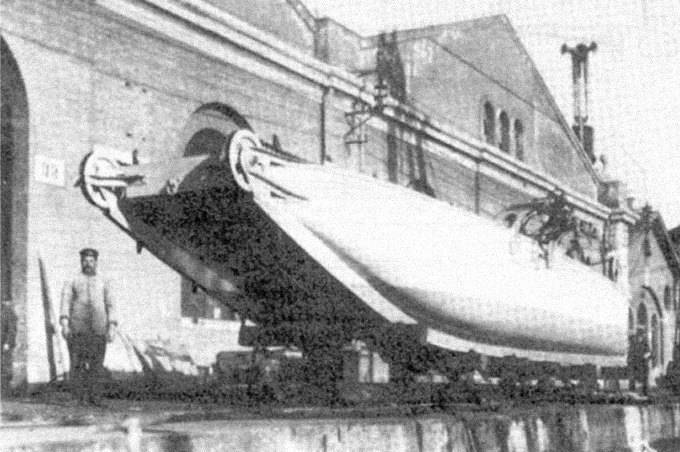
On the night of May 1, 1918 was attempted to strike at the ships that were stationed in the main base of the Austrian fleet of Pop. "Grillo" managed to overcome two rows of booms and anti-torpedo networks, but after that it was discovered by patrol ships and undermined. In total, four such boats were built, and all of them were destroyed without reaching the goal, since their speed was clearly insufficient: even at the moment of launching the attack, they developed no more than an 3,5 node.
Separate samples of large, displacing up to 6 -th exploding boats were at the same time as part of the German fleet: they developed speeds up to 30 knots and carried up to 230 kg of explosives. 24 April 1916, one of them was used to attack an anchored English monitor. At the same time, the boat treacherously walked under the white flag, and on its deck "people" stood "quietly" - mannequins in sailor uniform, and the commander of the English ship suggested that someone escapes from the enemy's territory. The boat was aimed precisely - a severe explosion occurred at the collision, but the charge was too high, at the level of the side armor belt, and only for this reason the damage turned out to be insignificant.
Further development of the same idea of a high-speed exploding boat, but having significantly smaller dimensions, is connected with the proposal of one of the Italian pilots. The aviation command began to develop the idea of attacking the enemy ships standing in the bases with ultra-small assault boats, which could be bombarded directly to the scene of action by air — by airplanes, or rather, by flying boats that could land on water.
Since the hull weight of these “aviation” boats, or rather motorchunks, was of paramount importance, the two experimental models had outboard motors, they had to be made ultra-light - with a tarpaulin “covering” on a fragile wooden frame. Improvement of the assault exploding boat went along the line of increasing reliability, and, consequently, weight. That is why it was necessary to focus on high-speed ships, equipped with special davits, or even on submarines with a cylindrical container-hangar. For submarines delivery, a series of special boats “MTR” (“tourist reduced”) was built, but the main, practically used surface attack tool during the war, was slightly larger 5,2-meter “MTM” - according to the first letters of the words “modernized tourist motor ".
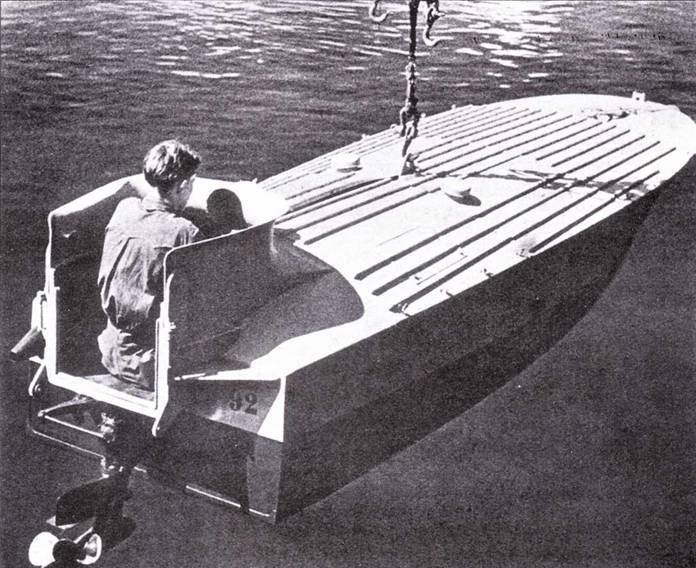
The autonomy of the voyage "MTM" with two 250-strong petrol Alfa-Romeo at a maximum speed of up to 32 nodes was about 5 hours. Swivel corner column when overcoming obstacles easily raised. In the forward part of the body was placed 300-kilogram explosive charge. Giving full speed, the driver fastened the steering wheel so that the boat went straight to the target, and he himself was thrown into the water and climbed onto the wooden liferaft, which had previously served as a backrest. When hit, a shock fuse was triggered, and powder cartridges located along the perimeter of the mid-frame, cut the hull of the boat in two. The nasal charging part, which had no reserve of buoyancy, went to the bottom, and after reaching a predetermined depth equal to the draft of the attacked target, it was undermined by a hydrostatic fuse: this allowed to strike the bottom of the ship's most vulnerable spot.
This is how events developed during the successful attack by a detachment of exploding “MTM” boats of British ships in Souda Bay on the northern coast of Fr. Crete in March 1941. Hurrying to complete the decisive operations in the Mediterranean before the planned attack on the Soviet Union, the German command set a goal, by all means, and as soon as possible to seize this island, which was of crucial strategic importance. The landing of the amphibious assault force was hindered by the fact that Crete was defended by the main forces of the English fleet, the 4 battleship, the 9 cruisers, over 20 destroyers. There were practically no German ships on the Mediterranean, and the Italian fleet, which the duçe was so proud of before the start of the war, had just suffered a whole series of cruel defeats.
It was then that the Italians who exploded boats remembered, capable, as it seemed, to strike back at the English squadron. In the afternoon of March 25, aerial reconnaissance detected the emergence of several ships and a group of British transports in their new naval base, the Court's bay. Two small destroyers, Francesco Crispi and Quintino Sella, immediately went to sea. Taking advantage of the ensuing darkness, they crept up about 10 miles to the base entrance. Of course, they didn’t have any chances to break into the well-guarded bay blocked by three rows of booms and nets: in this case, the destroyers played the role of carrier ships. Very quickly (they took only 35 seconds in training) they launched the boats, each of them took the helmsman’s place, and the detachment rushed to the target. During the night, six small "MTM" overcame all obstacles. The third row of obstacles they passed, clinging to the shore itself, however, and thus remained undetected, so the service was put in from the British. Then the Italians calmly waited for the dawn and distributed the targets: two of them were assigned to attack the cruiser, at which the wake-up was just starting - the whistles of the boatswain's horns could be heard.
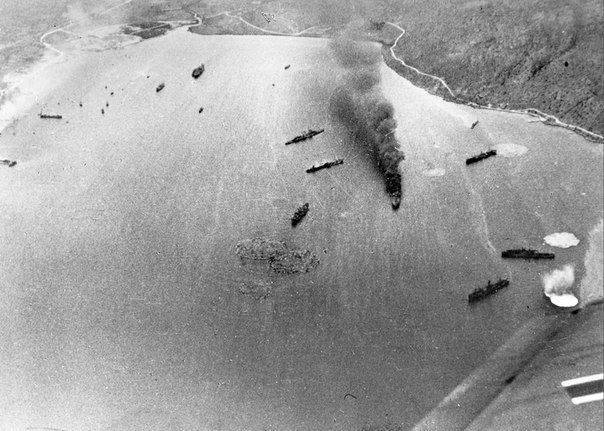
Here is what was stated in the report of the group commander L. Fajoni; “After the command“ Forward! ”Cabrini and Tedeski rush to the cruiser. Their boats quickly reach the maximum speed, and after a few seconds an explosion is heard, and immediately after it - the sounds of anti-aircraft guns firing at the missing aircraft. ” From the report of A. Cabrini: “First we go side by side at full speed. When we approached the cruiser on the 80, I secure the steering wheel and jump into the water; the boat is aimed at the center of the cruiser. Before I climbed onto the raft, I heard the sounds of the blows of two boats on the hull of a ship. I clearly hear first the explosions cutting the boats, and after a few moments underwater. Immediately I see a heavily tilted cruiser. ”
As it was already said at the beginning of the article, the undermined heavy cruiser “York” with a displacement of 18 000 T was the result of this attack, however, it is worth noting that in practice it did not give anything. As a result, the Germans had to take Crete not from the sea, but from the air. Losses at the same time were very large - 4000 paratroopers and 350 aircraft, and the time for the development of success was irretrievably lost. As the West German historian F. Ruge notes, the main forces destined to deliver the next attacks on Malta and the Suez Canal “had to be urgently redeployed to their initial positions for the campaign in Russia”.
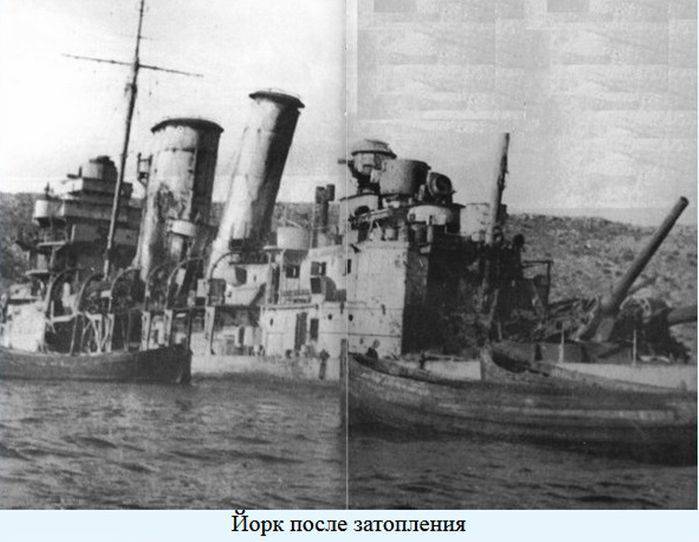
Nevertheless, the success of the attack on the bay of the Court suggested the idea of attacking in the same way the main base of the British - La Valette in Malta. When developing the operation, it turned out that it is almost impossible to break into the harbor of Grand Harbor through the main entrance; four lines of improved barriers would have to be overcome, and now it was impossible to expect surprise - the British, who had captured all six helmsmen in the Court's bay and carefully examined one unexploded "MTM", respectively, increased the base's security.
In addition, the Italians still did not know about the use by the British of new items - radar detection stations. The only option seemed to be a breakthrough through a narrow side passage under the bridge connecting the old fort of Sant Elmo with the north shore. However, a powerful anti-torpedo network hung from the bridge, reliably blocking the passage to the very bottom of the bay. In the end, it was decided to undermine this barrier with the help of submariners-saboteurs.
On the night of July 26, 1941, 8 exploding boats approached the bridge, but the explosion, which was supposed to open the way, was never heard: the network failed to destroy the network in time due to a trifling engine failure. When one of the boats rushed to the barrier, the unexpected happened: the farm of the bridge collapsed during its explosion completely blocked the passage. Unaware of this, the drivers of the remaining seven attacking boats rushed at full speed under the bridge and, flooded with the light of searchlights, hit by heavy crossfire, fell into a trap. “It was enough for a few seconds,” the English wrote later, “and all movement stopped on the surface of the sea.”
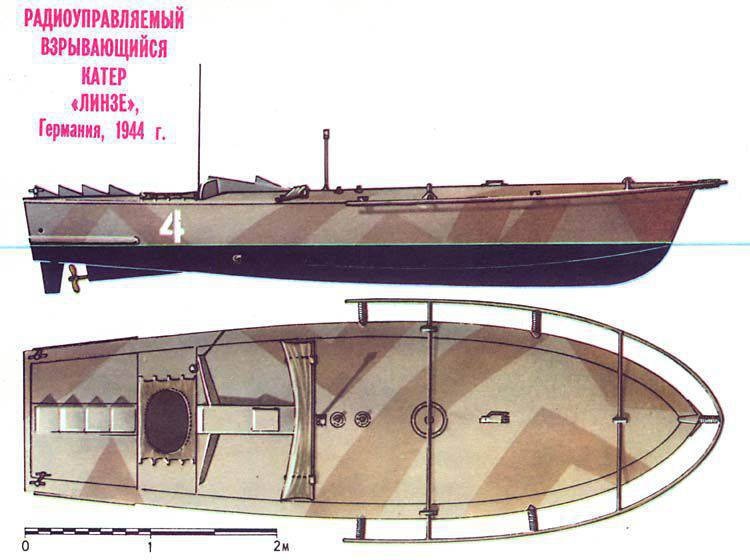
It is known that there were exploding boats and as part of the German fleet. As Admiral A.G., commander of our Northern Fleet, wrote in his memoirs. Golovko, by the time of the surrender of the Nazis, 230 of such boats and 240 human torpedo were concentrated only in the Norwegian bases. At the same time, a truly original sample of a radio-controlled "torpedo boat" was created by the gloomy Teutonic genius. In 1945, the Tornado project was developed. As a power plant on this boat, it was planned to use the Argus 109-014 jet pulsating engine, similar to that used on the Fi 103 projectile (FAA-1). The motor was to be mounted above the deck on special pylons. The boat itself was carried out in the form of a catamaran using aircraft floats. According to the calculations, the speed should have been 65 nodes.
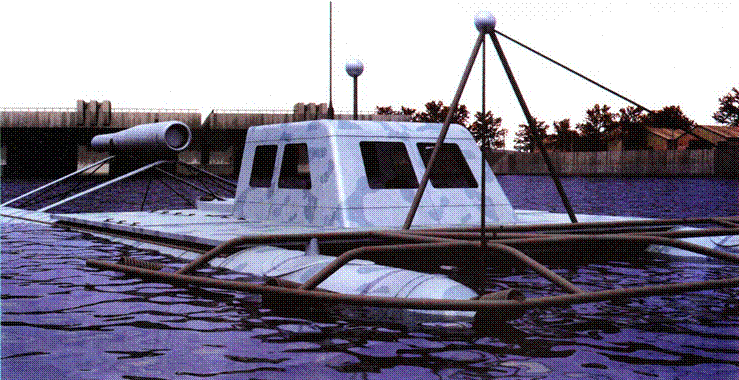
The development of surface assault vehicles and, in particular, exploding boats paid special attention to the Japanese fleet. At the time of the surrender of Japan, there were a huge number of its naval forces — about 6200 of such Shinio type boats. Obviously, this is the only case in the history of world shipbuilding when such a large series of combat boats was built. Their mass construction began in the 1944 year, at a wide variety of enterprises, including automobile plants and workshops not only in Japan, but also in Shanghai, Singapore, and Indonesia. Monthly 400-600 units were launched. "Shinio" had a length of 5,1 m; in the bow was placed 250-kilogram charge. One or two 67 automobile engines. with. ensured the speed of 18-28 knots. Having directed the boat at the target, the driver, like on the Italian MGM, was thrown into the water.
"Shinio" were used in the battles for Okinawa and the Philippines, but could not have a significant impact on the course of military operations. At the final stage of the war, the Japanese command, fearing the landing of American troops, concentrated in the bays and coves of the coast of Japan around 2000 boats to attack the enemy immediately, after anchoring the landing craft to anchor for unloading.
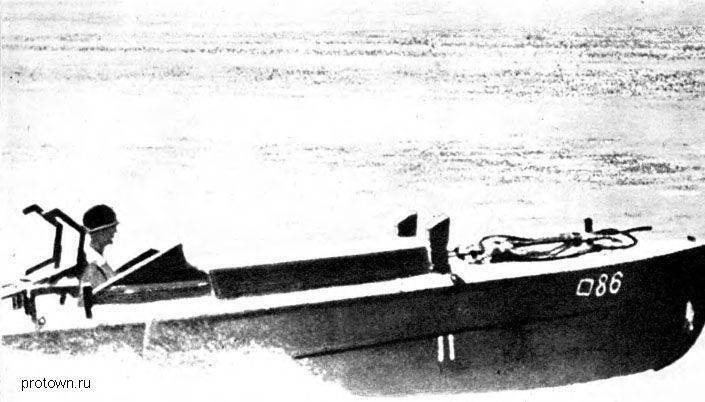
Exploding boats were used in the Second World War and the American fleet, especially after the landing in Normandy, when a bet was made on the expansion of the “button war” - a war using the latest technology. In particular, the Navy bombers sent to the Mediterranean received three large batches of exploded radio-controlled Apex boats to destroy coastal fortifications.
Apexes were used during amphibious operations in southern France on August 15 of the year 1944. In 1, the crews of the exploding boats, a mile from the coast, switched the steering wheel to radio control, transferred to the accompanying ships, and the Apex 18 aimed at the most important coastal fortifications. 15 of them exploded at different distances from the targets: huge fountains of water, clouds of smoke, fragments flew into the air; on two boats, the engines died out, and one lost control, turned aside and inflicted serious damage to his own submarine hunter.
As you can see, the use of exploding boats most often was unsuccessful. But even if successful, the impact of such sabotage operations on the course of battles in a particular theater, as a rule, turned out to be insignificant. And sometimes the boats simply were not allowed to go to sea. Here is one episode from the history of fighting in the Baltic during the Great Patriotic War. In the summer of 1942, the Hitlerites, who were besieging Leningrad, had a carefully disguised combination of high-speed assault boats based on Strelna. Having information about the use of exploding boats by the Italians and Germans in the Mediterranean, our command suspected that some of the Strelna assault boats might be designed to attack the most valuable Red Banner Baltic Fleet ships. The measures were taken in a timely manner: special purpose company’s water divers, I.V. Prokhvatilov was bombarded with anti-tank grenades.
Sources:
Borghese Yu., Becker K. Underwater saboteurs in the Second World War. M .: AST, 2001. C. 91-105, 629-630.
Shirokorad A. Italian MTM exploding boat // Admiral Oktyabrsky v. Mussolini. M .: Veche, 2011. C. 89-95.
Kofman V. Cater-saboteurs // Model-designer. 1988. No.4. C. 23-25.
Kosikov I. Exploding boats // Boats and yachts. 1983. No.2. C. 88-91.
Nenakhov Y. Miracleweapon Third Reich. Minsk: Harvest, 1999. C. 523-529.
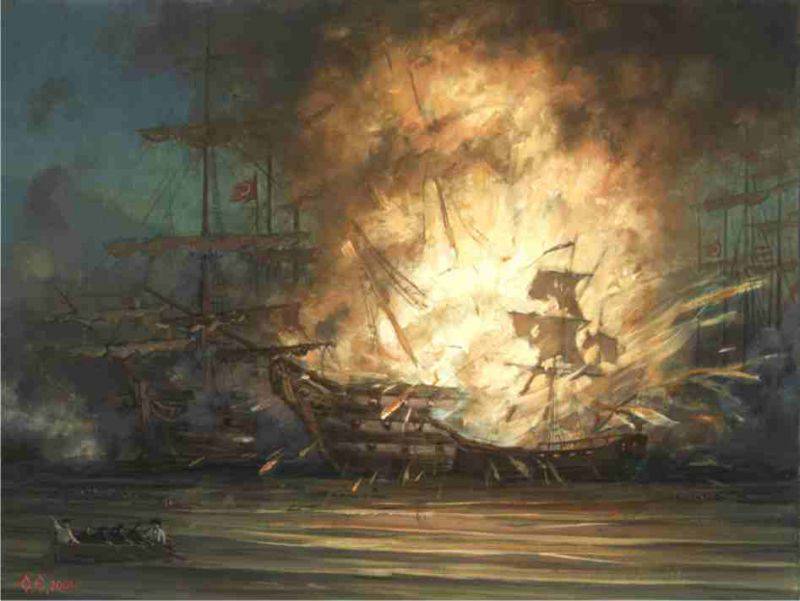
Information